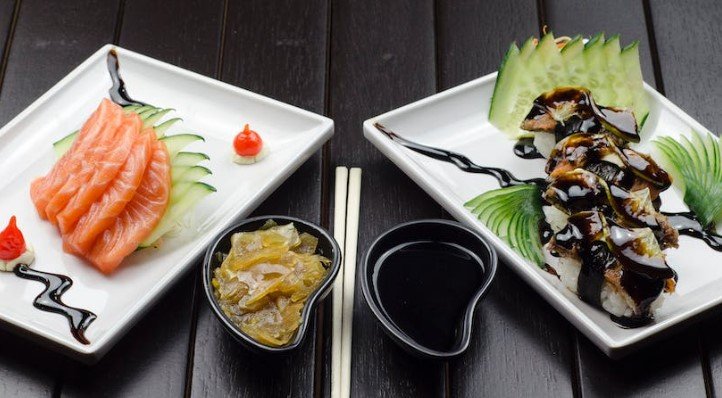Japanese cuisine is a style of food preparation originating from Japan that has evolved over the centuries and is now enjoyed around the world. It is a unique and diverse cuisine, renowned for its variety of ingredients and presentation. Its history dates back to ancient times, when the country was first unified by the emperor Jimmu in the 7th century BC. Since then, the cuisine has been shaped by its geography, climate, culture, and traditional agricultural practices. Over the centuries, it has become known for its use of fresh ingredients, its delicate flavors, and its distinctive presentation.
This article, “Japanese Cuisine Around the World: Celebrating Diversity and Fusion”, examines the diverse range of Japanese cuisine that has taken root in many countries around the world. It explores the history of how Japanese cuisine has become popular globally, looks at how it has been adapted to suit the local palates and cultures, and appreciates the unique fusion dishes that have been created as a result. Finally, it looks at how the popularity of Japanese cuisine is continuing to grow around the world, and the new opportunities this presents for innovation and experimentation.

Diversity of Japanese Cuisine
Overview of Traditional Japanese Cuisine
Traditional Japanese cuisine is known for its emphasis on fresh, seasonal ingredients and simple preparation methods. It is also characterized by its presentation in small, attractive dishes, and its use of various condiments and seasonings such as soy sauce, miso, and sake. Traditional Japanese dishes include staples such as sushi, tempura, and ramen, along with more unique offerings like oden and natto. The most popular dishes, though, are likely the rice-based dishes such as onigiri and donburi, which are typically served with the accompaniment of soup and pickles. In addition to the food, traditional Japanese cuisine also includes the presentation of sake, a fermented rice beverage that is often served alongside meals.
Regional Variations in Japanese Cuisine
Despite the overall similarities in traditional Japanese cuisine, there are some notable regional variations. For example, in the Kansai region of Japan, the traditional dish known as okonomiyaki is popular, while in the northern region of Hokkaido, ramen noodles are the go-to dish. In the southern region of Kyushu, the local specialty is tonkotsu ramen, a pork-based soup. Similarly, the Okinawa region is known for its unique cuisine, which includes dishes like goya champuruu, a stir-fry made with bitter melon.

Local Ingredients and Culture
The flavors and ingredients of Japan’s regional cuisines are largely determined by the local environment, culture, and history of the region. For example, in the mountainous regions of Japan, the traditional dishes are often more complexly flavored and incorporate a range of ingredients such as mushrooms, root vegetables, and wild game. In the coastal regions, the cuisine is typically lighter and fresher, incorporating fish and seafood. The cultural influences of the region also play a role in determining the cuisine, with some regions being known for their use of spices and robust flavors, while others are more mild and subtle. Ultimately, the diversity of Japanese cuisine is a reflection of the country’s distinct regional culture and local ingredients.
Japanese Cuisine Goes Global
The Rise of Japanese Cuisine
In the past few decades, the popularity of Japanese cuisine has grown in the West. While sushi has become a well-known dish, there are a variety of other traditional dishes that are becoming popular in the West as well. This includes ramen, tempura, and teriyaki. It is believed that the rise in popularity of Japanese cuisine in the West is due to its reputation for being healthy, fresh, and flavorful. Additionally, the presentation of dishes is often considered to be visually appealing and this has helped to increase the popularity of Japanese cuisine in the West.
Globalization and Travel in the Spread of Japanese Cuisine
Globalization and travel have played a major role in the spread of Japanese cuisine around the world. As people travel, they are exposed to different types of cuisine and this exposure has helped to spread Japanese cuisine to different parts of the world. Additionally, globalization has created a more interconnected world in which people can access different types of cuisine with relative ease. This is why Japanese cuisine has become so popular in the West, as it is now much easier for people to access the ingredients and recipes necessary to make traditional Japanese dishes.
The Impact of Japanese Cuisine
The influence of Japanese cuisine on other cultures and cuisines is undeniable. For example, the popularity of sushi has led to the creation of fusion dishes, combining traditional Japanese ingredients with flavors from other cultures. Additionally, Japanese ingredients and techniques are becoming increasingly popular in other cuisines, such as the use of miso paste in French cooking. As Japanese cuisine continues to spread around the world, it is likely that it will continue to have an impact on other cultures and cuisines.
Overall, Japanese cuisine has become increasingly popular in the West in recent years and this trend is likely to continue. Globalization and travel have played a major role in the spread of Japanese cuisine, and its influence on other cultures and cuisines is undeniable. As Japanese cuisine continues to spread around the world, it is likely that more people will be exposed to traditional Japanese dishes and ingredients, leading to a greater appreciation for the cuisine.
Fusion Cuisine
Definition of Fusion Cuisine
Fusion cuisine is a type of cooking that combines elements of different culinary traditions. It usually involves taking traditional ingredients, techniques, and flavors from one culture and combining them with those from another culture to create a unique, innovative dish. This type of cooking has become increasingly popular over recent decades and is often seen as a way to explore and honor different cultures. Fusion cuisine typically takes the best of both cuisines and creates something new and exciting. Fusion dishes are often creative, colorful, and flavorful.
Examples of Fusion Cuisine
Fusion cuisine often incorporates ingredients and techniques from different cultures. For example, a popular fusion dish is sushi pizza, which combines elements of Italian pizza and traditional Japanese sushi. Sushi pizza is a flatbread crust that is topped with sushi rice, seaweed, and various other ingredients like fish, vegetables, and sauces. Other fusion dishes that use Japanese ingredients or techniques include ramen burgers, Japanese-style fried chicken, and Japanese-style tacos. All of these dishes take traditional Japanese ingredients and techniques and combine them with other cuisines to create something unique and delicious.

Benefits and Challenges of Fusion Cuisine
Fusion cuisine can be a great way to explore different cultures and discover new flavors. By combining cuisines, it allows people to experience a range of different flavors and textures. Fusion cuisine can also be a way for people to try something new and exciting, and it can encourage creativity in the kitchen. Fusion dishes are often very colorful and can be a great way to make meals more visually appealing.
However, there are some challenges associated with fusion cuisine. It can be difficult to get the balance right and create a dish that is both flavorful and visually appealing. Fusion dishes can also be difficult to replicate as they often require a lot of experimentation and skill. Additionally, fusion dishes can be expensive to make as they often require ingredients from different cultures, which can be costly.
Japanese Cuisine and Health
Japanese cuisine is famous for its unique blend of flavours and ingredients, but what many people do not realise is that it can also have significant health benefits. The cuisine emphasises the use of fresh and natural ingredients, as well as low-fat cooking methods such as steaming, grilling and frying. In this article, we will take a closer look at the health benefits of Japanese cuisine and how it can promote a healthy lifestyle, as well as its popularity in global markets as a healthy and delicious alternative to other cuisines.
The Health Benefits of Japanese Cuisine
One of the main health benefits of Japanese cuisine is the emphasis on fish and seafood as a source of protein. Fish contains omega-3 fatty acids, which are essential for brain function, heart health and reducing inflammation. Additionally, the traditional Japanese diet includes a wide variety of vegetables, which are high in vitamins, minerals and antioxidants. These ingredients are often prepared using cooking methods that preserve their nutrient content, such as lightly steaming or stir-frying.
Another important aspect of Japanese cuisine is the use of fermented foods, such as miso, soy sauce and pickles. Fermented foods are rich in beneficial bacteria, which can improve digestive health and boost the immune system. Finally, traditional Japanese meals are often served in small portions, reducing the risk of overeating and obesity.
Japanese Cuisine in Promoting a Healthy Lifestyle
Japanese cuisine is not only healthy in terms of its ingredients, but also encourages a healthy lifestyle through its social and cultural practices. For example, the Japanese custom of eating slowly and mindfully can help prevent overeating and improve digestion. Additionally, the emphasis on communal dining and sharing of dishes promotes social interaction and can reduce feelings of loneliness and isolation.
Japanese Cuisine in Global Markets
In recent years, Japanese cuisine has become increasingly popular in global markets as a healthy and delicious alternative to other cuisines. Japanese restaurants can be found in almost every major city around the world, and many people are now familiar with dishes such as sushi, tempura, and ramen.
Healthy Japanese cuisine has become a trend in many countries, and restaurants are now using locally sourced and organic ingredients to cater to health-conscious diners. Additionally, Japanese cuisine is often seen as a gourmet and upscale option, with many high-end restaurants offering unique and creative dishes that appeal to food enthusiasts.
Conclusion
In conclusion, the health benefits of Japanese cuisine are many, from the use of fresh, natural and nutrient-rich ingredients to the social and cultural practices that promote a healthy lifestyle. Its popularity in global markets as a healthy and delicious cuisine is a testament to its importance in promoting good health and wellbeing.
FAQ
1. What is Japanese cuisine, and how is it different from other types of Asian cuisine?
Japanese cuisine is a style of cooking and preparing food that originates from Japan. Unlike other types of Asian cuisine, Japanese cooking often emphasizes the use of fresh, seasonal ingredients with minimal seasoning or spices to showcase the natural flavors of the ingredients. Additionally, Japanese cuisine also incorporates a variety of cooking techniques, such as grilling, steaming, and braising, to create unique textures and flavors.
2. What are some popular Japanese dishes that have become popular around the world?
Sushi and sashimi are two of the most popular Japanese dishes that have become popular around the world. Other popular dishes include udon or soba noodles, tempura, yakitori, and ramen.
3. How has Japanese cuisine been influenced by other cultures?
Japanese cuisine has been heavily influenced by other cultures, particularly Chinese and Korean cuisine. Techniques like stir-frying and the use of soy sauce in cooking are believed to have originated from China, while many Japanese dishes, such as ramen and Korean-inspired yakiniku, have evolved to incorporate other cultural influences.
4. Are there any particularly unique or unusual Japanese dishes?
Yes, there are many unique and unusual Japanese dishes that might be considered an acquired taste. Some examples include natto (fermented soybeans), fugu (pufferfish), and basashi (raw horse meat).
5. How can I find Japanese cuisine in my area if I’m interested in trying it?
There are a variety of ways to find Japanese cuisine in your area if you’re interested in trying it. You can do a quick online search for Japanese restaurants or sushi bars in your area, check out Yelp or other restaurant review sites, or ask for recommendations from friends or coworkers who are familiar with Japanese cuisine.
